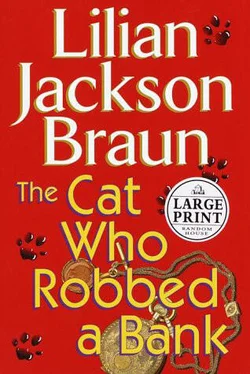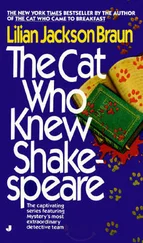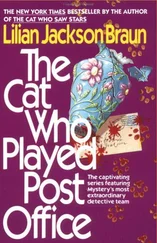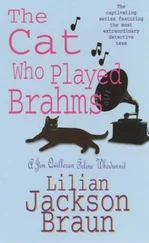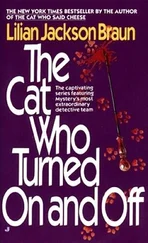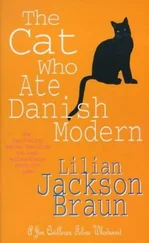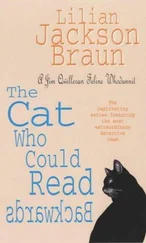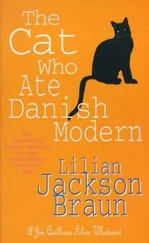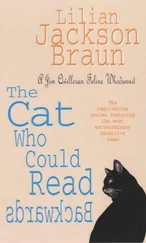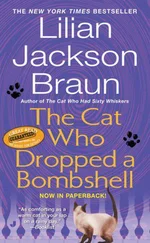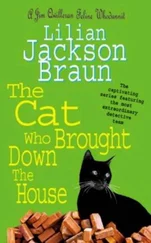Lilian Braun - The Cat Who Robbed a Bank
Здесь есть возможность читать онлайн «Lilian Braun - The Cat Who Robbed a Bank» весь текст электронной книги совершенно бесплатно (целиком полную версию без сокращений). В некоторых случаях можно слушать аудио, скачать через торрент в формате fb2 и присутствует краткое содержание. Год выпуска: 2000, ISBN: 2000, Издательство: Random House Large Print, Жанр: Старинная литература, на английском языке. Описание произведения, (предисловие) а так же отзывы посетителей доступны на портале библиотеки ЛибКат.
- Название:The Cat Who Robbed a Bank
- Автор:
- Издательство:Random House Large Print
- Жанр:
- Год:2000
- ISBN:9780375408786
- Рейтинг книги:3 / 5. Голосов: 1
-
Избранное:Добавить в избранное
- Отзывы:
-
Ваша оценка:
- 60
- 1
- 2
- 3
- 4
- 5
The Cat Who Robbed a Bank: краткое содержание, описание и аннотация
Предлагаем к чтению аннотацию, описание, краткое содержание или предисловие (зависит от того, что написал сам автор книги «The Cat Who Robbed a Bank»). Если вы не нашли необходимую информацию о книге — напишите в комментариях, мы постараемся отыскать её.
The Cat Who Robbed a Bank — читать онлайн бесплатно полную книгу (весь текст) целиком
Ниже представлен текст книги, разбитый по страницам. Система сохранения места последней прочитанной страницы, позволяет с удобством читать онлайн бесплатно книгу «The Cat Who Robbed a Bank», без необходимости каждый раз заново искать на чём Вы остановились. Поставьте закладку, и сможете в любой момент перейти на страницу, на которой закончили чтение.
Интервал:
Закладка:
They looked at him blankly and waited for him to leave so they could enjoy a nap on the new bar stools.
For his own breakfast he thawed a roll and took it to his studio on the first balcony, along with a mug of extra-strength coffee brewed in his automated coffeemaker. There he finished his Friday column, a tongue-in-cheek dissertation on the advantages and disadvantages of indoor plumbing. Only Qwilleran could write a thousand words on a subject of such delicacy and make it entertaining as well as educational without being scatological.
He handed in his copy to a skeptical managing editor, bantered with the crew in the cityroom, grabbed a burger at Lois’s Luncheonette, and browsed among the preowned books in the dusty secondhand bookstore. Still he arrived early at the hotel for his appointment with the designer.
After the bombing of the historic building, the Klingenschoen Foundation had purchased it from the Limburger estate, and Qwilleran had insisted that a local designer be commissioned to do the interior. Now, while waiting for Fran Brodie, he stood on the sidewalk across the street and conternplated the scene. The three blocks of downtown Main Street reflected an era when the county’s quarries were going full blast. Buildings and pavement were made of stone a bleak prospect until the city’s recent beautification effort. Now the chipped flagstone pavements were replaced with brick. Young trees were planted close to the curb. Brick planter boxes were filled with petunias, tended by volunteers.
In the middle of the block stood the three-story cube of granite that had long been the city’s only hotel and most disgraceful eyesore. It had a long history: built in the 1870s… gutted by fire in the 1920s and cheaply rebuilt… known as an overnight lodging that was gloomy but clean!
“It was so clean,” said the natives, “that the porcelain was scrubbed off the bathtubs!”
After being bombed by a psychopath from Down Below, it required a year to rebuild, refurnish and rename. Already two national magazines were interested in photographing the interior.
Windows that had previously stared balefully on Main Street were now flanked by wooden shutters painted in the theme color of rust. The entrance was more inviting than before; a broad flight of stone steps led up to double doors of beveled wood and etched glass. And across the facade were stainless steel letters mounted directly on the stone. They spelled:
T H E M A C K I N T O S H I N N
As everyone in Moose County knew, Qwilleran’s mother had been a Mackintosh. If she had not been a wartime volunteer, and if she had not met Francesca Klingenschoen in a canteen, and if they had not become lifelong friends… there would be no Mackintosh Inn. As a boy he had written letters to “Aunt Fanny.” After his mother’s death and numerous crises in his own life, he resumed the correspondence and eventually found himself named as her sole heir.
Qwilleran’s reverie was interrupted by a pinch on the elbow and the sound of a woman’s well-modulated voice: “Well, what do you think of the old dump?”
He gulped involuntarily. “Fran, I wish my mother could see this.”
“Wait till you see the interior!”
They dashed across the street during a lull in the traffic, and as they stood at the foot of the broad front steps she explained, “This is the ceremonial entrance. In the rear we have a carriage entrance at ground level, close to the parking lot and with immediate access to the elevators.”
“Elevators? Plural?” he asked in pleasure and surprise.
“Two of them. They operate like a dream! No clanking, no jerking, no stopping between floors. Isn’t it wonderful?…Now, before we go inside, I want to brief you on a couple of details. The interior is done in the Arts & Crafts period. Do you know about that?”
“Vaguely. Tell me.”
“It came after Victorian and before Art Deco. In England the leader was William Morris… in Scotland, Charles Rennie Mackintosh… in the U.S., Gustav Stickley. Their designs are in museums and private collections. We’ve furnished the inn with new versions of historic originals…. Got it?”
“Got it. Let’s go.” As they walked slowly up the steps he gazed at the entrance doors in admiration. “Old?”
“No. Custom-made for us in North Carolina. The wood is fumed oak. The etching was inspired by a William Morris tapestry.”
In the lobby Qwilleran, who was not prone to gasp, actually gasped! The mood was hospitable, the colors warm: rust, mellow browns, and other earth tones. There was much fumed oak… ceiling-beams where none had been before… large leather-cushioned chairs with wide wood arms… tables with ceramic tile tops… lamps with wood bases, pyramidal shades of mica, and pull chains! The mica gave a golden glow. The new reception desk had a welcoming air.
“The old one,” Qwilleran observed, “resembled the booking desk at the police station” Then he saw the large oil painting on the far wall: a life-size portrait of a woman seated at a piano. “That’s her! That’s exactly how she looked!”
It was a portrait of Anne Mackintosh Qwilleran in a peachcolored dress. Paul Skumble, the portraitist from Lockmaster who refused to copy photographs, had painted her likeness from Qwilleran’s memories: “People said she looked like Greer Carson but with larger eyes… Her hair was brown and medium-length; she called it a pageboy… Her hands looked slender and fragile at the keyboard; she had a baby grand… I remember a peachcolored dress with pearl buttons down the front, and a bracelet with foreign coins dangling from it.”
From this sketchy description the artist had created an astounding likeness complete with bracelet. And he had gone to the trouble of finding a video of an old Greer Garson movie.
Qwilleran said to Fran, “Actually she never wore the bracelet while playing the piano. It jangled. But we won’t tell anyone”
“She has a gracious aristocratic look.”
“True, but I didn’t think of it in those terms when I was a kid. I just thought it was motherliness a kind of calm, fond assurance that ‘mother knows best’…. I have to phone Paul and congratulate him.”
“Wait till tomorrow,” she suggested. “He’s coming to the reception.”
“In his usual ragged jeans and paint-spattered T-shirt?”
“Please! I personally dragged him to Bruce’s Tuxedo Rental and talked him into trimming his beard just a trifle, not enough to crush his personality…. Are you ready to see the rest of the building?”
The dining room was now the Mackintosh Room with white tablecloths and black-lacquered Stickley chairs. They had square-spindled backs and upholstered seats covered in the Mackintosh tartan. That was red, with a dark green stripe, and the carpet was dark green. The focal point on the back wall was a large Mackintosh crest in wrought iron, said to come from a Scottish castle gate. It had a cat rampant and the clan motto: Touch not the cat bott a glove.
The coffee shop was now called Rennie’s and was done in the style of a Glasgow tea room designed by Charles Rennie Mackintosh.
There was a ballroom on the lower level that would be the scene of the opening reception, Mr. Delacamp’s Tuesday Tea, and all future luncheon meetings of the Boosters Club.
The guest rooms, furnished in Stickley, were Fran’s chief pride. She said, “I’ve traveled extensively and stayed in luxury hotels with lavish furnishings but no place to put anything down! That’s my pet peeve, and I designed these rooms to be functional as well as attractive.”
Qwilleran asked, “Where will Mr. Delacamp camp while he’s here?”
“In the presidential suite. No president ever stayed here, but there’s still an adjoining room for the Secret Service, and it’ll be used for his assistant.”
Читать дальшеИнтервал:
Закладка:
Похожие книги на «The Cat Who Robbed a Bank»
Представляем Вашему вниманию похожие книги на «The Cat Who Robbed a Bank» списком для выбора. Мы отобрали схожую по названию и смыслу литературу в надежде предоставить читателям больше вариантов отыскать новые, интересные, ещё непрочитанные произведения.
Обсуждение, отзывы о книге «The Cat Who Robbed a Bank» и просто собственные мнения читателей. Оставьте ваши комментарии, напишите, что Вы думаете о произведении, его смысле или главных героях. Укажите что конкретно понравилось, а что нет, и почему Вы так считаете.
